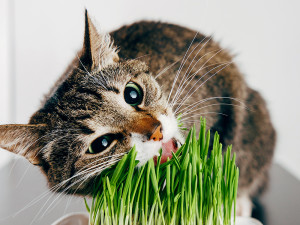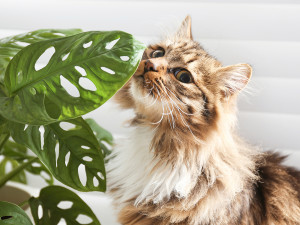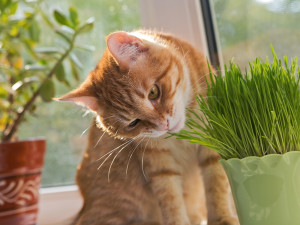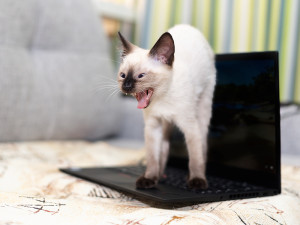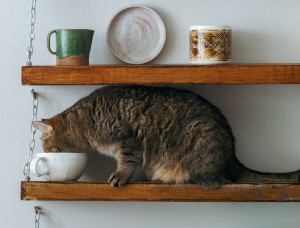How to Stop Your Cat From Munching On All of Your Precious Plants
Tips to get your cat to quit eating your greens.
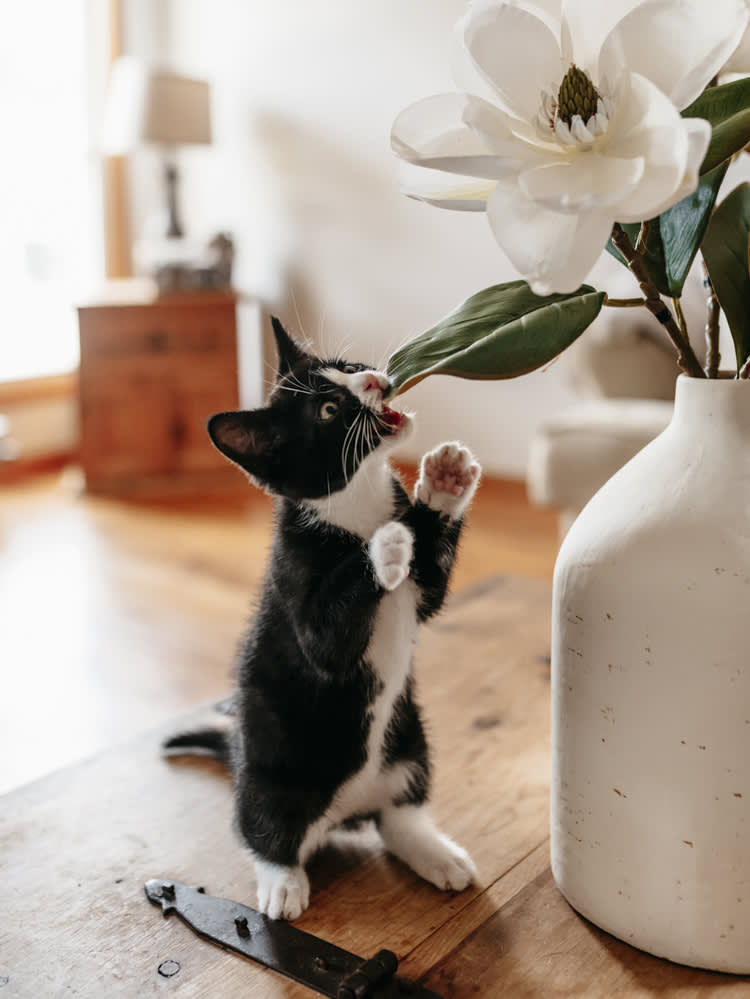
share article
Since at least March 2020, your plants have been your babies. You carefully chose them, picked out the pots that would fit their size and needs, and watched as they thrived in your new lockdown-hellhole-turned-greenhouse.
Enter: your cat, who also spent all of lockdown with you and, like your plants, continues to live in your home. You’ve done your research to make sure your plant children are not toxic to your cat child, and that’s a good thing because your kitty cannot stop nibbling on the peromia plant in your windowsill.
Facepalm forever.
Why Does My Cat Eat My Plants?
The answer may be unsatisfyingly simple. Wild felines regularly ingest plants, and it seems to be a behavior that our domestic cats have inherited from their ancestors. Many cats eat plants because they enjoy the taste. Others consume plants because they are bored, stressed, or attracted by the movement of the plants.
Young cats are more prone to plant-eating than older cats, which suggests that their playfulness and attempts to entertain themselves may be a part of the plant-eating puzzle. There is some evidence that cats — carnivores though they are — take an interest in plants when they need a little help with their digestion. Eating plants is not a way to expel fur balls, though many people have suggested that it is.
Can My Houseplants Be Saved From My Cat?
You’re spending so much time and effort trying to sneak kale into your morning smoothie and get your daily intake of vitamins and greens. Sadly, the only one who’s truly on board is the lone individual who shouldn’t be eating green things — the cat. Your houseplants are suffering from this feline fetish with flowers (and leaves and stems). You want to make sure your cat is safe, first and foremost, and also protect your plants.
What Can Be Done About It?
Behavior change always poses a challenge, and it’s almost always easier with a combination of approaches — some prevention and management, some allowing them to do what comes naturally to them in a safe way, and some active behavioral modification.
Cats can’t chew on plants they can’t reach, so making your treasured potted plants inaccessible is one part of the plan for harmony in the home. Strategically placing hanging baskets can keep those dangling leaves out of reach — for example — and so can floating shelves. In the case of plants that are truly dangerous to cats, I advise putting them in rooms the cats don’t have access to or even gifting them to cat-free friends for the safety of all. Common toxic houseplants include lilies, philodendrons, English ivy, pothos, snake plants, and dieffenbachia.
Cats find plants appealing, but if we can make them unappealing, the chewing behavior ceases. Many cats don’t care for citrus, so you can put water with lemon, lime, or orange juice in low concentration n a spray bottle and spritz it on house plants. You can also put aluminum foil around the base of the plant; a lot of cats find stepping on foil unpleasant.
Give Them Another Option
Sometimes, the best way to avoid behavioral problems is to offer an acceptable alternative. Create a garden for your cats full of things they can consume like goblinsopens in a new tab. So, instead of telling your cat not to chew plants at all, you are giving the instruction, “Chew these plants, not those plants.” Catnip, silver vine, cat thyme, and rosemary are all cat-friendly plants to consider, though it’s always wise to check with your veterinarian to find out which options are best for your particular cat.
Boredom is the enemy of a well-behaved cat, so make it easy for your cat to leave the plants alone by making plenty of other options for entertainment available. Enrichment options include catios opens in a new taband cat treesopens in a new tab, boxes to use as tunnels, and food puzzlesopens in a new tab. Playful cats often love the motion of the leaves and vines of houseplants, so offering opportunities to play in other ways — either with you or with toys on their own — often results in saving the plants.
Basically, in order to save your sweet, fragile plant babies, you just need to put in a little effort to appease your cat. Truly, what’s new?

Karen B. London, PhD, CAAB, CPDT-KA
Karen B. London, Ph.D., is a Certified Applied Animal Behaviorist and Certified Professional Dog Trainer who specializes in working with dogs with serious behavioral issues, including aggression, and has also trained other animals including cats, birds, snakes, and insects. She writes the animal column for the Arizona Daily Sun and is an Adjunct Professor in the Department of Biological Sciences at Northern Arizona University. She is the author of six books about training and behavior, including her most recent, Treat Everyone Like a Dog: How a Dog Trainer’s World View Can Improve Your Lifeopens in a new tab.
Related articles
![An angry and hissing Siamese kitten standing on top of a laptop computer in the living room]() opens in a new tab
opens in a new tabYou Don’t Have to Live Like This—You Can Get a Trainer For Your Cat
Tips to help you find a legit behaviorist (according to a veterinary behaviorist).
![Gray cat sniffing a glass on a shelf]() opens in a new tab
opens in a new tabHow to Scent Train Your Cat
A veterinarian on how nosework and scent enrichment can strengthen your bond.
![Cat eating out of metal bowl]() opens in a new tab
opens in a new tabTop 10 Foods That Are Toxic to Cats
Sharing isn’t always caring. Keep your cat safe by keeping these human snack staples to yourself.
